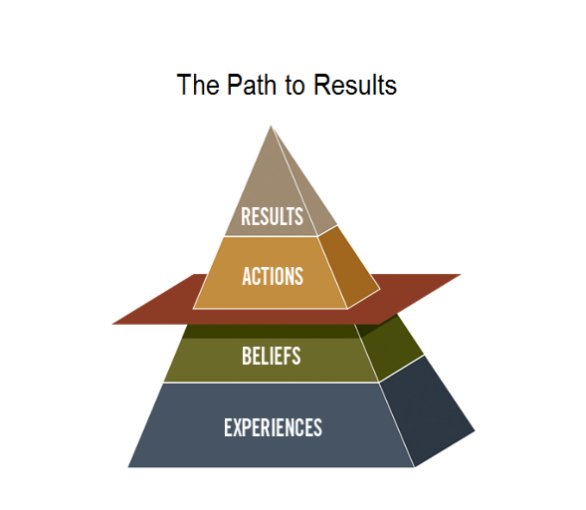To build an agile DevOps culture it’s essential to have the right tools. The tools should help implement and deliver quicker, easier automated outcomes. It frees up your developers to do more of the work they love, allows immediate updates to your website - creating a happier marketing team.
It’s essential to know not only who your external customer is, but also your internal customer too. It goes without saying that serving your internal customer has the knock-on effect of the business delivering more to the end customer as well.
Alongside fantastic tools, we also need fantastic people. People who are engaged in what they are doing and living the beliefs of a true DevOps culture.
Great culture drives great accountability, which helps deliver the results that we want. This article is the first in a 5-part series that will examine how we can create a better culture to help you deliver more of the stuff that matters.
Changing culture is similar to CI/CD. It has to happen all the time in real time. It comes from the top but is something that’s built and designed by the whole team. Long gone are the days of senior management deciding on the criteria for results and marking them up on the walls. They get read, they get forgotten and they aren’t applied.
Currently you’re here, getting these results. That’s the culture you’ve allowed to flourish. Let’s call these results R1. Maybe they are terrible, maybe they’re ok, or maybe they are great but there are still some things that you know should change.
Whether good or bad, you will be getting results. These results are delivered by the culture that has been adopted in the team or organisation. Sometimes the culture is intentionally designed and sometimes it isn’t, it develops based on the experiences, beliefs and actions that happen.
Whilst development and selection of tools can be complicated, culture shouldn’t be. It should be simple.
You’ve got the people and you’ve got the tools - what’s next? How do we generate this accountability to help us get the results we want?
The Line of Accountability
Culture is the way people think and act. For DevOps to be successful, it’s mission critical to build a culture of accountability. Accountability isn’t about blame, it’s about your people doing the right thing. Acting above the line of accountability. This is where great things happen. Your team are more willing to take calculated risks and be the ‘go to person’. More often than not, people are more fixed on survival. Protecting themselves rather than getting results that the company needs. This leads to all the things we are constantly battling and coming up with new tools to help eradicate – silos, poor communication between people teams and external businesses and stakeholders.
So, what can be done to change this? Getting your team on the same page. Let them be part of the team that decides on the results, and educate them on accountability and what it truly means to deliver to the team or business.
Empowered Teams
Empower your team to star in the solution, fix the problem or encourage them to step forward. This will start to shift the types of results you will see. A shift in desired results drives the shift in culture. It is essential to maintain a positive approach to accountability, even when things don’t go according to plan. Being above the line will enable your team to move forward, get results and feel satisfied.
We all exhibit classic below the line tendencies, and whilst it can’t be helped, we should do our best to minimise the amount of times it happens. This can include venting frustrations, moaning about a situation or team member not pulling their weight. Being below the line too often means you will never get the results you want. It causes people to cease up and become increasingly annoyed with the situation.
The more time spent above the line, the greater the results. It builds a culture of accountability, allows people to grow and perform better. People will start thinking and acting differently when they are aligned and bought into the company’s results.
Accountability through responsibility
For accountability to work everyone needs to take responsibility for anything that comes their way;
- They see it – flag when a new challenge is seen
- Own it – being accountable for it
- Solve it – What else can I do. This could also mean briefing a member of the team to do some work on it, but the original team member should still be tied to it.
- Do it – the last step, do what you say you will.
Accountability isn’t something that should happen when things go wrong. It’s about acknowledging and celebrating that whether the outcome is what was wanted or not, the team were acting above the line.

The Pyramid of Results
The results pyramid is built up of 4 layers, Experiences, Beliefs, Actions and Results.

EXPERIENCES foster beliefs,
BELIEFS influence actions
ACTIONS produce results.
The most useful tool for the process of culture shift is the Results Pyramid. It is the single most powerful tool that you have that will have the most impact and make the most change, it’s also likely to be the simplest tool too. The pyramid can help you understand where you are at the moment, and help to plan where you would like to be in the future.
The experiences, beliefs and actions of the people in your team will dictate the culture and in turn dictate the results you get. If the results you are getting aren’t right, whether than be financial or quality it will come down to the culture.
Every action that a manager takes creates experiences. It could be interaction in a meeting, promotion of a team member or creation of new policies. These experiences lead the rest of the team to their beliefs – ‘this is how it works round here’. And once they believe something, they’ll act on it, and that delivers the results.
Positively building on these will have an impact. The impact will be difficult to measure directly, but over time whatever metric you are measuring will change.

Shifting From Culture1 to Culture2
The first step is to assess the current culture using the pyramid. Current experiences, beliefs and actions. For this to work your team need to be engaged and their needs to be a policy of open and honest conversation without fear of criticism or judgement.
Once culture1 is mapped out and agreed and it is understood what results you are currently getting and why, it is time to start looking and the results you want to achieve. The list will likely be long, and part of the process is to reduce that list to a manageable selection of results and outcomes.
These are your Results2. Over the next few instalments of this blog we’ll take a closer look at the experiences, beliefs and actions and how we can use these starting at the bottom of the pyramid to start delivering on the results we want to achieve.
Do you want to hear more about Dataweavers has helped customers with their DevOps processes? Check out our success stories here.






